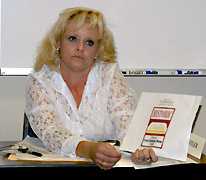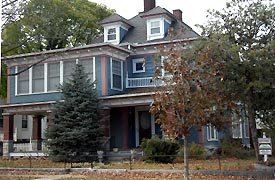
Joy Kistler, a respected member of the Joplin Historic Preservation Commission holds up a design for a historic marker to be placed in front of properties designated as landmarks.
Historic preservation hadn't been much of an issue in Joplin. Buildings were torn down without regard to the history behind them. Others, including the old Fox Theatre building were degraded by renovations that included the use of distasteful metal or plastic facades.
Now under the guidance of Dick Largent, head of planning and community development, new life is being breathed into the city's historic preservation commission. However, the novice group is still unsure of the role they are supposed to play.
Designation of historic landmarks was the topic recently discussed by the group meeting at Joplin City Hall, 6th & Main. Although Largent told them that it was their job to design signage for this project, they were a bit hesitant in making decisions on this topic started three years ago and not moved forward until now.
The group's concern over the cost factor of the signage was alleviated with the suggestion by Mary Anne Phillips, the city's recycling coordinator, that the City's machine shop be utilized. However, Largent asked them to put together a budget that he could present to the city council for approval of the use of planning and community development funds.
With no official historical society in Joplin to act as a voice for preservation or to encourage the collection of historical data, the commission, according to Largent, needs to assume these roles. "It's your job to judge the importance of property designated as historic," Largent told the group that had spent considerable time bantering back and forth over what colors should be used for the signage.
In order to help determine what structures should qualify for signage, a suggestion was made to pick the brains of Brad Belk, director of the Joplin Museum Complex that houses the Dorothea B. Hoover Historical Museum. Anyone doing research on the history of the area capitalizes on the vast knowledge Belk has. Unfortunately, with no information computerized or filed for easy retrieval local researchers have found that the museum itself thwarts research.

What originally was the Adam Scott residence, circa 1900, sits on the corner of 2nd and Sargeant in Joplin. A part of the Murphysburg Residential District, the house is designated by a historic marker found in the righthand corner of the picture. Grandfathering in this sign is something that the Joplin Historic Preservation Commission needs to consider as well as working with Historic Murphysburg Preservation, a private group organized to promote historic preservation throughout Joplin.
"Dispel the notion of Victorian or other flavor necessary for a listing on the Historical Register," Largent said in helping them determine what should qualify as a landmark property for signage. He reminded them that criteria for design already has been established in order to quality for federal and state tax credits.
Named to a downtown design review committee were commission members Steven McCollum and Carolyn Lake. They will serve with 4 others to certify the appropriateness of renovation design plans prior to business owners being awarded building permits. The City is encouraging business owners to take advantage of grant money to refurbish their building facades to resemble an original look of the 1900s, especially in the area that includes the 400 and 500 blocks of Main St. that has been rezoned as a historic district called the Sunshine Lamp District.
Design review standards for the Joplin commercial area were compiled by Thomason and Associates of Nashville, TN in a report submitted in August 1992 and revised in May 2005. Their report stresses the need for design standards "to reinforce community identity, encourage economic growth and development, and extend the life of a building or structure."
Local buildings listed on the National Register of Historic Places
Nine "commercial" buildings mentioned by the Thomason and Associates' report as being listed on the National Register in Joplin are:
- Newman Bros. Bldg. (now City Hall), 602-08 Main St.
- Fox Theatre (now Central Christian Center), 415 Main St.
- Rains Bros. Bldg., 906-08 Main St.
- Joplin Union Depot, First & Main
- Elks Club Lodge #501, 318-320 W. 4th St.
- Scottish Rite Cathedral, 505 Byers Ave.
- Joplin Carnegie Library, 9th & Wall
- St. Peter the Apostle Catholic Church and Rectory, 812 Pearl
- St. Louis and San Francisco Railroad Bldg. (Frisco Building), 605 Main St.
Once a railroad depot and commercial building, the Frisco Station was renovated by Carlson-Gardner of Springfield and made into low and moderate income senior citizen apartments.
The Zahn, 320 S. Wall, a 6 story building built in 1918 and the Ridgway, two three story buildings built in 1913 have been nominated for listing on the National Register in order to qualify for historic preservation tax credits. Carlson-Gardner together with the Economic Security Corp. of Joplin are working to secure funding of $9 million to renovate these buildings in order to create affordable housing for young professionals and their families.






Comments